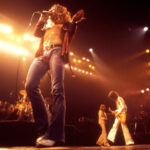Spring’s arrival is heralded by a symphony of sounds, and among the most recognizable and cheerful is the song of the Northern Cardinal. As a backyard nature enthusiast, I’ve always been captivated by the melodies of these vibrant red birds, alongside other avian vocalists like Tufted Titmice, Mourning Doves, and House Finches. The drumming of Downy and Red-bellied Woodpeckers adds a rhythmic percussion to this natural orchestra. These songs are more than just pleasant background noise; they are vital communications as birds attract mates and establish their nesting territories. Over the years, my yard has become a haven for nesting birds, hosting at least nine different species. Observing these families, I’ve experienced the highs and lows of nature – the delight of successful fledglings and the sadness of nesting failures, each moment a valuable lesson in the intricate world of backyard birdlife.
Male Red-bellied Woodpecker diligently working on his nest cavity in early spring.
In February 2018, the persistent tapping of a male Red-bellied Woodpecker drew my attention to a dead Black Cherry tree in my yard. This snag, intentionally left to provide habitat, is a hub of activity for various woodpeckers, including Downy, Hairy, Pileated, and Northern Flickers, all foraging for insects under its bark. Chickadees, Nuthatches, and Brown Creepers also frequent this tree, seeking out insect morsels. Witnessing the Red-bellied Woodpecker begin excavating a nesting cavity was a promising sign of spring.
A Red-bellied Woodpecker pair collaborating on nest excavation, showcasing teamwork in nature.
Day after day, regardless of the weather, the Red-bellied Woodpecker worked tirelessly on his nesting hole. Initially, only his head fit inside, but gradually, he disappeared further into the cavity. Eventually, a female joined him, and together they shared the labor. One would enter to work inside, then call out to the mate, who would then enter to remove wood chips and sawdust, spitting them out of the hole. This fascinating process of nest creation is a testament to the dedication of these birds.
Male Red-bellied Woodpecker diligently ejecting sawdust, a crucial step in creating their nest cavity.
Excavation concluded by early May, and in mid-May, the female was observed carrying food – a clear indication that hatchlings had arrived. Anticipation grew to see young Red-bellied Woodpeckers peering from the nest. However, nature can be unpredictable. A few days later, agitated calls from the Red-bellies near the nest were followed by a disheartening discovery: European Starlings emerged from the hole. These invasive cavity nesters had evicted the woodpecker family, ending their nesting attempt prematurely.
A European Starling, an invasive species, peering from the usurped Red-bellied Woodpecker nest cavity.
Fortunately, other cavity-nesting birds in my yard have experienced greater success. For species that don’t excavate their own cavities, I’ve installed nesting boxes designed for Tufted Titmice, Carolina Chickadees, and House Wrens, with entrance holes sized to deter House Sparrows and European Starlings. To minimize disturbance, nest boxes are monitored sparingly, no more than once a week.
Tufted Titmouse eggs nestled safely in a backyard nesting box, a secure start to life.
Over the years, my focus has been on planting native trees and shrubs that support insect life, particularly caterpillars. It’s crucial to remember that a vast majority – ninety-six percent – of terrestrial North American birds rely on insects, spiders, and arthropods to feed their young. Even hummingbirds supplement their diet with tiny insects for their offspring. Caterpillars, rich in protein, are a preferred food source for nestlings. Given that 90% of caterpillars and leaf-eating insects specialize in specific plants, a diverse array of native plants is essential to support a diverse insect population.
Tufted Titmouse nestlings awaiting their next meal, highlighting the bustling life within a nest box.
According to entomologist Doug Tallamy, Carolina Chickadee parents must provide an astonishing 6,000 to 9,000 caterpillars to raise a single clutch of chicks to fledging! Thanks to the native plants in my yard, Chickadees have successfully raised two broods annually for over a decade. Tufted Titmice and House Wrens have also thrived, raising multiple broods in nesting boxes. A three-year study in suburban Washington, DC, further emphasizes the importance of native plants. Researchers found that Carolina Chickadee nesting success was directly linked to native plant abundance, with at least 70 percent native plants needed for successful fledging. Larger birds like Red-bellied Woodpeckers require even more insects, underscoring the critical role of native plants in supporting bird populations.
House Wren parent with a caterpillar, a vital protein source for rapidly growing nestlings.
Cup-nesting birds like American Robins, Northern Cardinals, Song Sparrows, and Mourning Doves also find my yard suitable for nesting. Robins have nested in various locations, from vines to downspouts. These birds, including the Northern Cardinal, whose vibrant song brightens the yard, rely on native plants for insects to feed their young. They also need dense native vegetation for nest structure and predator concealment.
Carolina Chickadee eggs, small marvels representing new life in the backyard ecosystem.
Eastern Red Cedars in my yard have been particularly successful nesting sites for Song Sparrows and Mourning Doves. These evergreens offer dense cover, protection from predators, and host over 40 caterpillar species, making them ideal for nesting and foraging. The cheerful “cheer cheer cheer” song of the Northern Cardinal is often heard from these cedars, a sign of their presence and contentment in the habitat.
Carolina Chickadee nestlings, nearly ready to fledge and embark on their own adventures.
Tips for Encouraging Nesting Birds in Your Yard:
If you wish to attract nesting birds to your yard and enjoy the sounds of birdsong, including the distinctive Northern Cardinal Song, consider these lessons I’ve learned:
- Choose the Right Nesting Box: Research birdhouse dimensions suitable for your desired species and mount it at the recommended height.
American Robin eggs nestled in a Trumpet Honeysuckle vine, showcasing natural nesting preferences.
-
Install Predator Guards: Predator guards made of wood or hardware cloth can deter raccoons and squirrels. Baffles can be added below pole-mounted boxes.
-
Minimize Nest Disturbance: Check nests no more than weekly, and avoid checking when fledglings are near to leaving to prevent premature fledging.
American Robin nesting creatively in the crook of a downspout, adapting to available structures.
-
Skip Nesting Material: Birds prefer natural materials. If you provide any, avoid long strands to prevent entanglement, and never use treated lint or hair.
-
Remove Plastic Debris: Plastic can be hazardous nesting material. Ensure your yard is free of plastic that birds might incorporate into nests.
Mourning Dove nest camouflaged within the dense foliage of an Eastern Red Cedar, a safe haven.
-
Return Featherless Nestlings: If a featherless baby bird is on the ground, return it to the nest. Feathered fledglings on the ground are likely being cared for by parents nearby.
-
Keep Cats Indoors: Protect birds by keeping cats indoors year-round.
Song Sparrow nestlings nestled in an Eastern Red Cedar, benefiting from the tree’s protective cover.
-
Avoid Pesticides and Herbicides: A healthy habitat naturally balances insect populations.
-
Avoid Pruning During Nesting Season: Refrain from trimming shrubs and trees during nesting season.
House Wren parent delivering a bug, with a predator guard ensuring nestling safety.
- Clean Nesting Boxes Annually: Clean boxes at the end of the season to provide roosting space and reduce parasites.
House Wren eggs in a nest incorporating feathers and, unfortunately, potentially harmful plastic strips.
Above all, take pleasure in the birds that visit and nest in your yard. By planting and maintaining native plants, you contribute to a habitat that provides ample food and shelter, ensuring these beautiful creatures, including the melodious Northern Cardinal, continue to grace our backyards with their presence and songs for generations to come.
Northern Cardinal nest nestled in Virginia Creeper, a testament to the beauty of backyard bird nesting.


